1 A bumble bee’s life
How do bees go to school? On the school buzz!
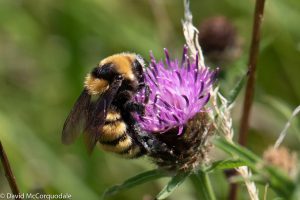
It is important to understand a bumble bee’s life cycle for many reasons. Firstly, knowing when bumble bees are active will help us know when to find them! This is essential if we are trying to protect a species at risk. For example, if we know when queen bumblebees should be emerging from their nests in spring, we can go out and try and find them in the wild! This is very helpful for scientists who are trying to gather data on bumblebee populations.
Secondly, understanding the life cycles of bees is important if we want to document how species are reacting and adapting to climate change. Are queen bumble bees emerging from their burrows earlier or later than they have in the past? When do we start seeing the queen’s first batch of workers? Is this timing different compared to previous years? These questions can give us an idea of how a species of bumble bee is performing despite the impact of climate change and other environmental and human-related disturbances.
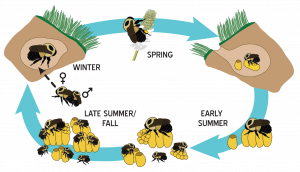
Bumble bee Life Cycle
May until June: Queen bumble bees awaken after spending the winter months underground. A queen spends her time searching for a nest site and foraging on flowers. When she finds a nest, she will lay a brood of eggs and she will take care of them until they become mature adults (female workers). It is important to note that these queen bumble bees are much larger than your average worker bumble bee.
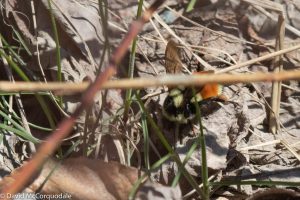
Mid-June until Early August: In the early summer months, all of the bumble bees you’ll see are female workers (plus the original Queen) who are busily working to keep the colony in tip top shape. Some workers take care of the nest on the home front whereas others head out to forage on flowers and return to the nest with valuable resources; nectar and pollen! The queen stays in her nest laying eggs during this time. At this time, there are dozens to a few hundred small worker bumble bees in a nest. This is why you’ll see more bumble bees during this time of year.
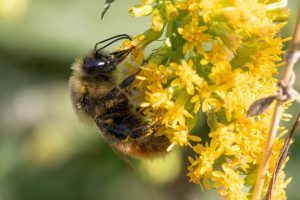
End of August until Early September: By the very end of August, we start to see male bumble bees out and about. Males leave the nest right away and do not return. At this time, the worker bumble bees are much larger than the ones we saw during the peak summer season.
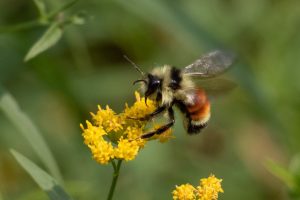
Mid-September until October: By late September, we see a few lingering workers, some gynes searching for nests, and wandering males. A male bumble bee’s role is to mate with the potential queens (gynes). After they mate, the potential queens burrow underground for the winter until spring.
The only reproducing bee in a bumble bee colony. This bee overwinters in a burrow and spends the majority of spring building her colony of workers.
A change in the average conditions — such as temperature and rainfall — in a region over a long period of time (Source: NASA Climate Kids. Visit Site.)
The action of a bumble bee gathering pollen and nectar.
A female bumble bee that completes different tasks inside and outside the hive to keep things in tip-top shape. A female descendent of a queen bumble bee.

